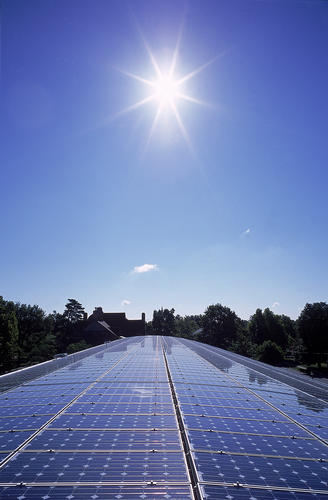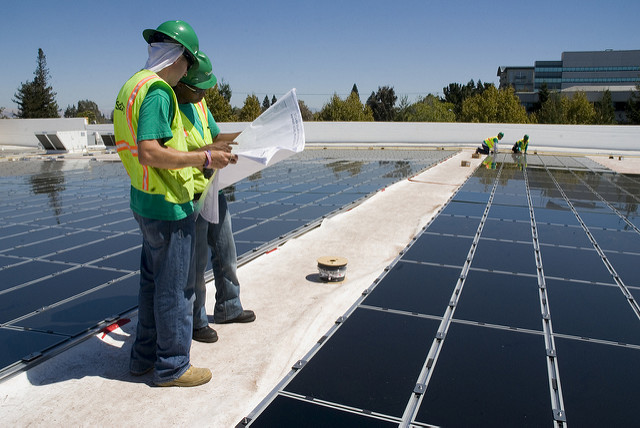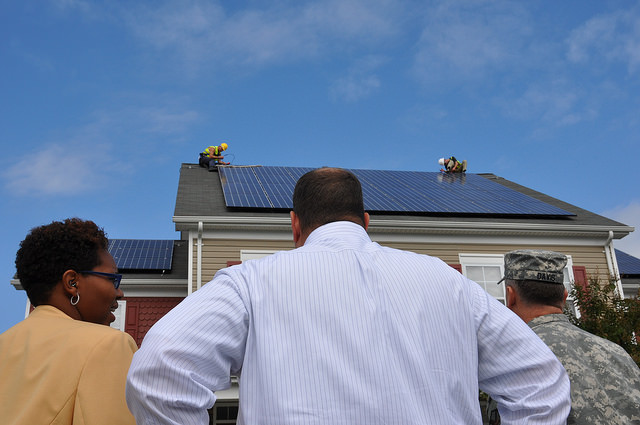
The bills keep piling up and the energy bill never seems to get any cheaper. Sound about right? As a homeowner, you know the value of a dollar. And you feel the pain when your electric bills are abnormally high. Maybe you live in the south and your July bill came in at over $300. Maybe you live in the Midwest, where the winters are brutal, and your energy bill hit over $400 because your heat has been running non-stop. Maybe you have a family of 8 and the laundry never stops – you’re pretty sure your washer and dryer has been running without a break since last Tuesday. Whatever the reason, it’s happening to all of us. In fact, recent statistics show that energy bills rise about 3% every year. If you think your bills are expensive today. . .I wonder what they’ll be like 10 years from now. What if you could save money on your energy bills every month? Would you be interested in hearing how you can? Just look to the sky – the answer is overhead: the sun. What if you could power your home through solar energy? It’s not a sci-fi novelty anymore. It’s happening. And it’s happening more than you think.
The Prevalence of Solar Energy Use
There are three main reasons people install solar energy systems in their homes: a) cost savings, b) environmental benefits (reducing your carbon footprint), and c) having energy independence (not relying on those high-priced electric utility companies to power your home). Solar panel systems first starting gaining steam in the 1970s and 1980s; recent renewable energy reports suggest that by 2050, solar energy will be the most widely used source of electricity across the globe.

Solar power is simply the conversion of sunlight into energy. And this is accomplished through two methods: use of solar photovoltaics (direct approach) or using lenses or mirrors to concentrate sunlight into a small beam (indirect approach). As the systems get more advanced, the price of solar energy continues to decrease. The majority of homeowners who install solar power systems in their homes are still connected to the grid for when there isn’t enough stored solar energy to power their home (e.g., during the night). In these situations, users live the majority of the time off of solar energy, but can continue to enjoy no interruptions to their power when the sun goes down. In fact, not only are your energy bills cheaper, you’re eligible for financial incentives for installing solar systems within your home. In some rural areas, you can live completely off the grid – when it’s not feasible for the power companies to provide power so far out. As you can imagine, this type of setup takes close monitoring of how much energy is used, because once you’re out, you don’t have a backup source (i.e., the grid) to connect to.
Types of Solar Panels
There are three main types of solar panels: monocrystalline, mulitcrystalline, and thin film. And each has their own advantages and disadvantages. To learn the best system for you, let’s take a look at the basics. If you’re interested in getting solar panels installed in your home, read the facts here first and then call an installer to discuss what would be best for your needs, your home, and your checkbook.

The overwhelming majority of solar panels are made out of a material called crystalline silicon. And the purity of the silicon is the distinguishing characteristics of the two most common types: monocrystalline silicon and multicrystalline silicon.
Monocrystalline Silicon Solar Panels
The highest purity silicon solar panels, monocrystalline silicon panels, are also the most expensive, most developed, and have been around the longest. These panels derived their name from the singular, continuous crystal structure, leading to the uniform appearance of the solar panels. This uniform appearance is apparent through the single flat color of the panels. The solar cells that make up monocrystalline silicon panels are cylindrical with rounded edges; monocrystalline panels, as the name suggests, are made up of single crystal silicon. Manufactured solar cells for monocrystalline silicon panels (ingots), are made through the Czochralski method, where crystal structures surround each ingot. Four sides are cut out of each ingot, to make silicon wafers, resulting in the famous cone shape of these types of solar panel components.
![]()
Why would you be more inclined to buy monocrystalline silicon solar panels over multicrystalline or thin film panels?
- Monocrystalline silicon panels are the most efficient solar panels on the market, converting ~20% of sunlight into energy.
- These types of crystalline silicon panels take up the least amount of space and are ideal if you live in a home that has compromised room for solar system placement.
- Monocrystalline silicon panels will provide a greater and faster return on investment because of their higher efficiency over other types of solar panels.
- Monocrystalline silicon panels have a 25-year life expectancy, one of the longest over all three major types of solar panels.
- Monocrystalline panels tend to perform better in low-light conditions.
What are some of the disadvantages associated with these types of solar panels?
- The expense. These types of solar panels are pretty costly and you might not have the money for it. Though most efficient, some people just can’t swing the cost.
- Because of the process that these panels are made (see Czochralski method above), a large portion of these panels are cut out to form silicon wafers. Therefore, a significant portion of your purchased panel ends up as waste.
- Do you have a yard or live in an environment where an excess amount of snow, dirt, or shade could cover your panels? If so, the panels may cease to work and shut down the system. That is, monocrystalline solar panels are sensitive to circuit breakdowns.
Multicrystalline Silicon Solar Panels
Multicrystalline silicon solar panels differ from their monocrystalline counterpart because they are made of multiple fragments of silicon melted together, making them less pure. As you might see, this makes their efficiency less than the monocrystalline solar panels; but they are cheaper in comparison. The appearance is slightly different compared to monocrystalline silicon solar panels as well. Instead of uniform appearance of single-crystal design systems, multicrystalline silicon panels have more of a speckled blue color to them – resultant from the multiple crystals they are composed of.
![]()
Below are the advantages of multicrystalline silicon solar panels:
- They cost less – the process to make multicrystalline silicon solar panels is not as complex as monocrystalline panels. And, they do not have to go through the Czochralski method.
- Multicrystalline panels are melded into perfectly square molds and are not cylindrical shaped. That means that there is less waste.
Some of the disadvantages of multicrystalline silicon solar panels include:
- Because these panels are less pure, their efficiency is less than monocrystalline silicon panels. Monocrystalline solar panels convert about 22% of sunlight into energy, whereas multicrystalline solar panels convert ~16% of sunlight into energy.
- They will take up more space. This is because you’ll need to cover more ground with the panels to compensate for the lower efficiency of these panels.
- Some people are bothered by the color of multicrystalline panels because they are a speckled blue hue instead of a uniform black color of monocrystalline and thin film panels.
Thin-Film Solar Cells
Thin-film solar panels, also known as thin-film solar photovoltaic cells, are made by placing several layers of very thin photovoltaic material onto a substrate. Much less efficient than crystalline silicon panels, these types of solar cells are mostly advantageous because they are so cheap. In fact, if you have the space for them, this might be the most advantageous of all three types of solar panels.

Notice how much slimmer these panels are
In general, the advantages of thin-film solar cells include:
- They are easy to mass-produce and considerably cheaper to make than crystalline solar panels.
- They appear as a black uniform color, similar to the monocrystalline silicon solar panels, and are more aesthetically pleasing to some individuals.
- There is not much effect on these types of panels in fluctuating weather conditions or shady spots.
- If you have a lot of land, these types of panels are an excellent way to capture solar energy due to their cost and ease of installation.
When there are advantages, there are also disadvantages:
- Compared to crystalline silicon panels, the efficiency of thin-film solar cells is about 15% (if you’ll recall, monocrystalline solar panels have efficiencies ~20%).
- These types of solar panels are not feasible for most homeowners, because most homeowners don’t have the space they’d need to install the amount of thin-film solar panels needed to power their homes.
- Because you’ll need to install more thin-film panels over crystalline silicon models, your cost of necessary supplementary equipment (such as support structures and cables) will increase your overall costs.
- The life expectancy of thin-film solar panels is considerably less than the 25+ years attributed to crystalline silicon panels.
In Conclusion
Installing a solar energy system is a big decision and a big purchase. And, as technology advances, more and more options are becoming available. Ultimately, you’ll need to consider a number of things before purchasing solar panels, though cost and space are the big ones. Solar panels are very costly, but they have a huge return on investment. And with constant advancements in renewable energy, and exponential projected increases in the use of solar panels world-wide, going solar is a smart choice. Just take a look at your first energy bill after installing solar panels – that will help you realize the great decision you made.


